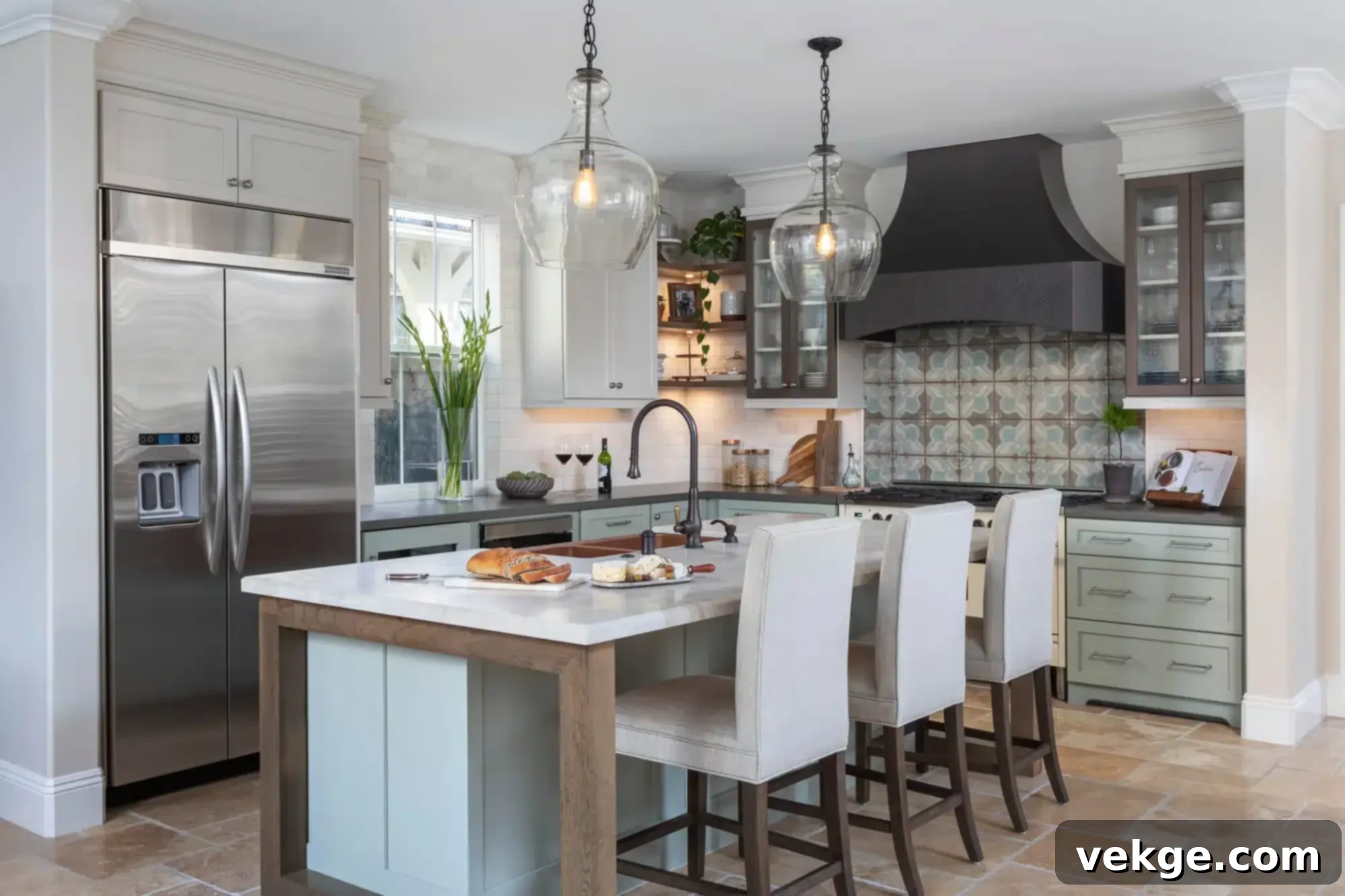The Ultimate Guide to Renovating a Farmhouse: Blending Historic Charm with Modern Comfort
Old farmhouses possess an undeniable, romantic charm, standing as enduring symbols of rural heritage and a simpler era. Their sturdy bones and rich history often beckon those dreaming of a ‘farmhouse-core’ lifestyle. However, transforming these venerable structures into a functional, comfortable, and stylish modern home requires careful planning and execution. This comprehensive guide is designed to walk you through the essential steps of remodeling an old farmhouse, helping you navigate the complexities, minimize stress, and avoid costly mistakes often associated with fixer-upper projects.
Embarking on a farmhouse renovation journey is more than just a home improvement project; it’s an opportunity to breathe new life into a piece of history while creating a personalized sanctuary. From initial assessment to final touches, we’ll explore key considerations to ensure your renovation is a success, preserving the farmhouse’s unique character while integrating contemporary conveniences and efficiency.
1. Assess the Current State of Your Farmhouse: The Foundation of Your Renovation
Before any demolition or design work begins, the most crucial first step in any farmhouse renovation is a thorough assessment of its current condition. This initial evaluation provides a realistic understanding of the scope of work required, helps in budgeting, and uncovers potential challenges. Don’t rush into tearing things down; careful investigation can save you significant time and money in the long run.
Professional Inspections Are Non-Negotiable
It’s highly recommended to work with a team of inspection experts. These professionals offer invaluable industry insight, identify both visible and hidden hazards, and ensure legal and regulatory compliance, especially for properties with historic value or designations. Key inspections include:
- Structural Integrity: Examine the foundation, walls, and roof for signs of distress such as uneven floors, sagging ceilings, significant cracks in interior and exterior walls, or signs of water damage. Foundation issues, for example, are critical and must be addressed early as they impact the entire structure.
- Hazardous Materials: Many older homes contain materials now considered health hazards. Professional testing for asbestos (commonly found in insulation, flooring, and siding) and lead-based paint (prevalent in homes built before 1978) is essential. Safe removal or encapsulation by certified professionals is paramount for your health and safety.
- Plumbing and Electrical Systems: Old farmhouses often feature outdated plumbing and electrical systems that cannot support modern demands. Look for ancient wiring (e.g., knob-and-tube), corroded pipes, or insufficient electrical panels. Upgrading these systems is crucial for safety, efficiency, and accommodating contemporary appliances and technology.
- HVAC Systems: Evaluate the existing heating, ventilation, and air conditioning (HVAC) systems. Older farmhouses may lack central air or have inefficient heating solutions. A modern, energy-efficient HVAC system will significantly improve comfort and reduce utility costs.
- Pest and Moisture Issues: Inspect for signs of pests (termites, rodents) and moisture intrusion, which can lead to rot, mold, and structural damage. Addressing these issues early prevents further deterioration and costly repairs.
Uncovering Hidden Charms and Challenges
Beyond potential problems, a thorough inspection can also reveal forgotten treasures. For instance, beneath layers of linoleum or carpet, you might discover original wide-plank wood flooring, which, despite its age, might be salvageable and add immense character. Similarly, original trim, built-in cabinetry, or unique architectural details might be waiting to be restored.
While the exterior of an old farmhouse might appear sturdy, the interior systems are often a different story. Original single-paned windows, for example, while historically accurate, provide poor insulation, leading to heat loss in winter and heat gain in summer. They are also prone to condensation and breakage. Upgrading to double or triple-paned, energy-efficient windows, installed by a replacement window contractor, is a smart investment for comfort and energy savings.

Careful inspection, like noticing cracks in both concrete and brick, is vital for identifying underlying structural issues such as foundation problems.
2. Plan Your Farmhouse Design: Vision Meets Reality
Once you have a comprehensive understanding of your farmhouse’s current state, it’s time to translate your vision into a concrete design plan. This stage is where your dreams of a modernized farmhouse take shape, balancing historical integrity with contemporary functionality.
Develop a Detailed Design Brief
A design brief is an indispensable document that outlines every aspect of your renovation project. It serves as a living guide for you, your architect, and your contractors, ensuring everyone is aligned with your goals. A comprehensive design brief should include:
- Project Overview: A concise summary of the renovation’s purpose, highlighting the farmhouse’s existing character and your desired outcome.
- Project Scope: Clearly define what areas will be renovated, what new features will be added (e.g., a new kitchen layout, additional bathroom), and what existing elements will be preserved or restored.
- Goals and Priorities: Articulate your key objectives. Is historical preservation paramount? Are you aiming for maximum energy efficiency? Do you need more open living spaces or additional bedrooms?
- Budget: A realistic estimate of material and labor costs. Include a contingency fund (typically 10-15% of the total budget) for unforeseen expenses.
- Timeline: A projected schedule for each phase of the project, from design and permitting to construction and completion.
- Lifestyle Requirements: Consider how you live and what you need from your home. Do you entertain frequently? Do you work from home? Do you have specific accessibility needs?
- Sustainability Requirements: Outline any specific eco-friendly goals, such as integrating renewable energy sources, using sustainable materials, or aiming for specific certifications.
- Aesthetic and Style Preferences: Gather inspiration from various sources like Pinterest boards, sample catalogs, and architectural magazines. Sketches or photos of desired looks communicate your aesthetic vision far more effectively than words alone.
Navigating Building Permits and Regulations
Before any physical work can begin, you’ll need to secure the necessary building permits. Each city, county, and state has its own set of building codes and zoning regulations. For historic farmhouses, there may be additional stipulations from local historical preservation societies or commissions. Researching these requirements early in the planning stage is crucial. Your design brief, complete with detailed plans and specifications, will be essential for permit applications. Working with an experienced architect or contractor who is familiar with local regulations can significantly streamline this often complex process.
3. Remodel Your Farmhouse: Executing the Vision
With a clear understanding of the farmhouse’s condition and a detailed design plan in hand, it’s time to begin the actual renovation. Executing the remodel in a logical order is key to efficiency and structural integrity.
Prioritize Structural and Core System Upgrades
Start with the most fundamental elements of the house: the core structure and essential systems. This phased approach ensures a solid foundation for all subsequent work.
- Foundation and Structural Repairs: Address any foundation problems first – sinking, bowing, or deterioration. The integrity of the entire house depends on a stable foundation. This might involve underpinning, crack repair, or drainage improvements.
- Exterior Envelope: Repair or replace the roof, siding, and windows. These elements protect the house from the elements and significantly impact energy efficiency. This is the ideal time to upgrade to modern, insulated windows.
- Major System Upgrades: Tackle electrical, plumbing, and HVAC system upgrades. Outdated systems are not only inefficient but can also pose safety risks. Modern wiring can handle today’s electronics, new plumbing ensures reliable water pressure and drainage, and efficient HVAC systems provide year-round comfort.
- Insulation: Improve or add insulation to walls, attics, and floors to enhance energy efficiency before closing up walls.
- High-Traffic Rooms: Once the structural and systemic foundations are laid, move on to high-traffic and high-impact areas like the kitchen, bathrooms, and living room. These areas typically require the most design detail and modern amenities.
Authenticity and Material Selection
One of the defining characteristics of a farmhouse renovation is the blend of old and new. While the temptation to cut corners with cheaper, modern materials might arise due to budget constraints, maintaining authenticity is often a key driver for renovating an older home. Where possible, use materials that are consistent with the original construction or those that complement its rustic charm.
This commitment to authenticity is particularly important for historically designated buildings, where renovations often require using the same materials and techniques as the original house. For example, features like shiplap – wooden boards that fit together with rabbet grooves to create a waterproof, durable wall covering – are emblematic of farmhouse style and, if original, should be carefully preserved or replicated with appropriate materials.

Utilizing traditional materials like robust wooden boards, often seen in elements like shiplap, helps maintain the historical integrity of your farmhouse.
Consider sourcing reclaimed wood for flooring or beams, restoring original doors and windows rather than replacing them, and choosing fixtures that reflect the farmhouse aesthetic while offering modern functionality. This approach not only preserves the home’s character but can also add significant value.
4. Ensure Energy Efficiency: A Smart Investment for the Future
After investing significantly in renovating your farmhouse, the last thing you want is high utility bills draining your finances. Enhancing energy efficiency is a crucial aspect of any modern renovation, offering long-term savings, increased comfort, and environmental benefits. A well-optimized home for energy efficiency is a wise investment.
Upgrade Insulation and Seal Air Leaks
Heating and cooling typically account for the largest share of household energy consumption. Poor insulation allows heat to escape in winter and infiltrate in summer, forcing your HVAC system to work harder. Improving insulation throughout your farmhouse is one of the most effective ways to lower energy bills.
- Attic Insulation: Often the easiest and most cost-effective place to add or upgrade insulation.
- Wall Insulation: Can be blown into existing wall cavities without major demolition or installed during a more extensive gut renovation.
- Floor Insulation: Especially important for homes with crawl spaces or unheated basements.
Beyond insulation, detecting and sealing air leaks is paramount. Thermal imaging cameras can help identify areas where warm or cool air is escaping. Once these leaks are found, they can be effectively sealed:
- Weatherstripping: Ideal for movable components like windows and doors, weatherstripping creates a seal that prevents air infiltration when they are closed.
- Caulking: A flexible material used to fill gaps and cracks between stationary building components, such as around window frames, door frames, and where different materials meet.

Effectively sealing gaps around windows and doors with caulk and weatherstripping is vital for improving your farmhouse’s energy efficiency.
Modern Energy-Saving Upgrades
Consider other energy-efficient upgrades:
- LED Lighting: Transitioning to LED lighting dramatically reduces energy consumption compared to traditional incandescent or fluorescent bulbs. LEDs last longer, emit less heat, and are more environmentally friendly due to the absence of toxic materials like mercury.
- High-Efficiency Appliances: When replacing kitchen or laundry appliances, choose Energy Star-rated models for significant energy and water savings.
- Smart Thermostats: Programmable or smart thermostats can optimize heating and cooling schedules, learning your habits and adjusting temperatures automatically, leading to further savings.
- Water-Saving Fixtures: Install low-flow toilets, showerheads, and faucets to conserve water without sacrificing performance.
Challenges and Issues in Farmhouse Renovation
While the dream of a renovated farmhouse is exciting, the path to achieving it is rarely without its hurdles. Preparing for common challenges can help you navigate them more effectively and maintain progress.
Budget Constraints: The Unforeseen Costs
Farmhouse remodels often exceed initial cost estimates. Unforeseen expenses, such as fluctuating material prices, unexpected structural damage, or hidden problems (e.g., extensive water damage, previously undetected foundation issues, or mold) discovered during demolition, can quickly inflate your budget. To mitigate these financial surprises:
- Contingency Fund: Always allocate a contingency fund, ideally 15-20% of your total budget, specifically for unexpected costs.
- Detailed Quotes: Obtain multiple, highly detailed quotes from contractors, ensuring they itemize all costs.
- Track Spending: Keep meticulous records of all expenses to identify potential budget overruns early.
Timeline Pressures: Delays are Inevitable
Renovation projects rarely adhere strictly to the original timeline. Delays can stem from various factors outside your control, such as severe weather, supply chain issues affecting material availability, or unexpected complications during construction. Effective planning and communication are your best tools:
- Realistic Timeline: Work with your contractor to establish a realistic timeline that accounts for potential delays.
- Regular Communication: Maintain open and consistent communication with your contractor to monitor progress, address issues promptly, and adjust the schedule as needed.
- Flexibility: Be prepared to be flexible. Minor delays are a normal part of the process.
Regulation Compliance: Navigating Bureaucracy
Understanding and complying with building codes, zoning laws, and historical preservation regulations can be daunting. The permit application process often involves extensive paperwork and can take weeks or even months for approval. Failure to comply with these legal regulations can lead to costly delays, fines, or even project shutdowns. Partnering with an experienced contractor or design team who has a strong understanding of local requirements is invaluable for ensuring all necessary paperwork is in order before construction begins.
Form vs. Function: Balancing Aesthetics with Modern Needs
Striking the right balance between preserving the authentic farmhouse style and integrating modern functionality can be challenging. Many contemporary comforts and technologies might seem at odds with a rustic aesthetic. Furthermore, incorporating sustainable practices is often a high priority for homeowners today. The key is thoughtful integration:
- Seamless Blending: Choose modern appliances and fixtures that complement, rather than clash with, the farmhouse’s character. For example, stainless steel appliances can still fit if balanced with rustic wood elements or classic cabinetry.
- Emphasize Rustic Details: Highlight original features like exposed beams, wide plank floors, and traditional millwork.
- Smart Design Choices: Incorporate sustainable elements like passive solar design or rainwater harvesting in a way that feels organic to the property.
Finding Skilled Labor: Expertise for Historic Homes
Renovating an old farmhouse, especially one with historic features, often requires specialized skills. Finding contractors, carpenters, and artisans who have experience with older homes and traditional building techniques can be a challenge. Seek out professionals who understand the nuances of working with aged materials and who share your appreciation for historical preservation. Ask for portfolios of previous work on similar properties and check references thoroughly.
Conclusion: Your Dream Farmhouse Awaits
Embarking on a farmhouse renovation project is undeniably one of the most exciting and rewarding endeavors a homeowner can undertake. It offers the unique opportunity to connect with history, create a truly unique living space, and enjoy the tranquil beauty of rural living, all while upgrading to modern standards of comfort and efficiency. However, as with any significant undertaking, it comes with its share of challenges and requires careful preparation.
By diligently following the four crucial steps outlined in this guide—thoroughly assessing the current state of the building, developing a detailed design plan, executing the remodel with a focus on structural integrity and authenticity, and prioritizing energy efficiency—you lay a solid foundation for success. While you will undoubtedly encounter common hurdles like budget constraints, timeline pressures, regulatory complexities, and the balance between old and new, remember that being well-prepared is your most powerful tool.
There may be no such thing as an entirely stress-free renovation, but with meticulous planning, the right team, and a clear vision, the process can be significantly less intimidating and immensely gratifying. Good luck on your journey to transforming your old farmhouse into the charming, functional, and energy-efficient home of your dreams!
